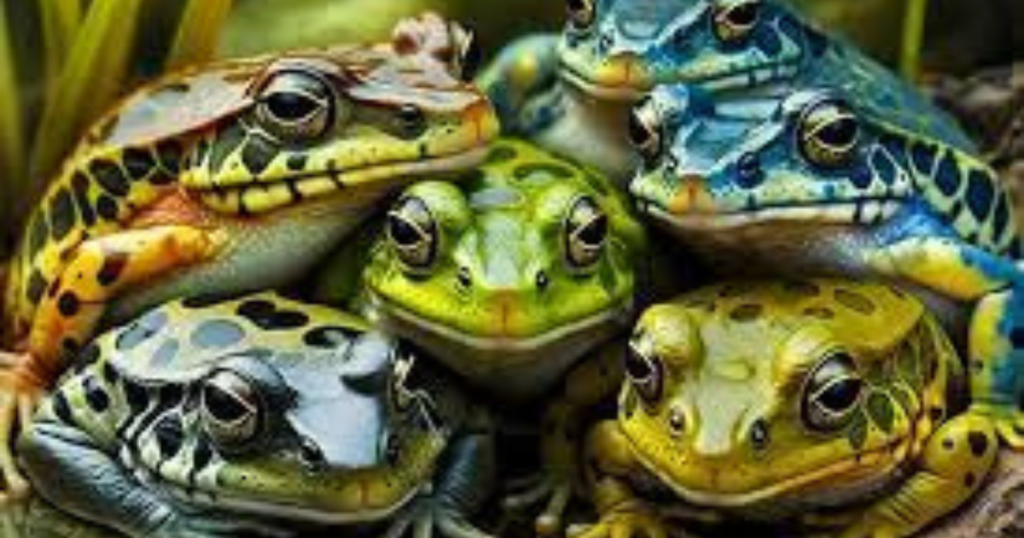Frogs are fascinating creatures that live in a wide variety of environments, from rainforests to deserts. They can be found on every continent except Antarctica. These amphibians play important roles in ecosystems, acting as both predators and prey. But have you ever wondered what a group of frogs is called? In this blog, we’ll dive into that question and explore some fun facts about frogs and their group behaviors.
A Group Of Frogs Is Called An “Army”
When frogs gather together, the correct term for a group of them is an “army.” This might seem like a surprising choice of words, but when you think about it, it makes sense. Frogs, especially during breeding season, gather in large numbers, creating a chorus of croaks that can sound like they’re getting ready for battle. The term “army” highlights the strength in numbers that frogs often display when they come together.
Why Are They Called An Army?
The term “army” isn’t just a random choice. There are several reasons why this name fits a group of frogs:
- Numerous Frogs in One Place: During certain times of the year, like the rainy season or breeding season, frogs gather in large numbers near water bodies. It’s common to see hundreds or even thousands of frogs in one location, all mating and laying eggs. The large number of frogs gives the impression of a strong, united force, like an army.
- Loud and Unified Sounds: When frogs gather, they make quite a noise. Male frogs use loud croaks to attract female frogs. If you’ve ever been near a pond or lake at night, especially in the spring or rainy season, you might have heard a chorus of frogs. The combined sound can be incredibly loud, almost like a roar. This unified “battle cry” might be another reason why a group of frogs is called an army.
- Coordinated Movements: While frogs may not march like soldiers, they do move together during migration or when seeking new habitats. This coordinated movement, with so many frogs hopping in the same direction, can resemble the organized behavior of an army.
Other Terms For Frog Groups
While “army” is the most commonly accepted term for a group of frogs, it’s not the only word used. Sometimes, people refer to a group of frogs as a “knot” or even a “colony.” These terms are less common but are still accepted in certain contexts.
Each of these terms reflects the nature of how frogs come together:
- Knot: This term may refer to how tightly packed frogs can be when they gather in large numbers, especially around breeding grounds.
- Colony: Similar to how we refer to groups of animals that live closely together, a colony can describe frogs living in the same pond, marsh, or swamp.
When Do Frogs Form Groups?
Frogs are typically solitary creatures for much of the year, so they don’t always form groups. However, there are specific occasions when they come together:
- Breeding Season: The most common time to see an “army” of frogs is during the breeding season. Male frogs gather near water bodies and begin their croaking, which attracts female frogs. Once the females arrive, the frogs mate, and the females lay their eggs in the water. This leads to a temporary congregation of frogs in one area, which is why we often associate large numbers of frogs with this time of year.
- Hibernation and Shelter: In colder climates, some frog species hibernate during winter. They may gather in groups in mud, under leaves, or in crevices to stay warm. By sticking together, they can increase their chances of surviving the cold. While this doesn’t always create the large “army” we might picture, it’s still a group behavior that serves an important survival purpose.
- Migration: In some regions, frogs migrate to find better habitats or water sources. These migrations, often triggered by seasonal changes, can lead to large numbers of frogs moving together. While not as dramatic as the migrations of birds or wildebeests, frog migrations can still involve impressive numbers of frogs traveling across land.
Interesting Facts About Frogs
Now that we know what a group of frogs is called, let’s explore some more fun and interesting facts about these amazing amphibians:
- Frogs Are Important Indicators of Environmental Health: Frogs are very sensitive to changes in their environment. Because they live in both water and on land, they are often the first animals to be affected by pollution, climate change, and habitat destruction. When frog populations decline, it’s often a sign that something is wrong with the ecosystem.
- Frogs Have Incredible Leaping Abilities: Some frogs can jump up to 20 times their body length. This helps them escape from predators and catch insects to eat.
- Not All Frogs Croak: While most people associate frogs with croaking, not all species of frogs make this sound. Different species have different calls, and some are even silent. Frogs may grunt, bark, or chirp depending on the species.
- Frogs Come in All Sizes and Colors: Frogs can be tiny, like the Paedophryne amauensis from Papua New Guinea, which is only 7.7 mm long, or huge, like the Goliath frog from Africa, which can grow up to 32 cm long. Frogs also come in a variety of colors, from green and brown to bright blue and red. Some frogs use their bright colors to warn predators that they are poisonous.
- Frogs Have Been Around for Millions of Years: Frogs have existed for over 200 million years, making them some of the oldest creatures on Earth. They survived the mass extinction that wiped out the dinosaurs and continue to thrive in various environments around the world.
Why Knowing Frog Group Names Matters
You might be wondering why it’s important to know what a group of frogs is called. Aside from satisfying curiosity, understanding the terms and behaviors of different animals helps us appreciate the natural world more deeply. The more we learn about animals like frogs, the better equipped we are to protect their habitats and ensure their survival.
Frogs, though small and often overlooked, play a crucial role in maintaining the balance of ecosystems. Knowing something as simple as the term for a group of frogs helps foster a sense of connection to these fascinating creatures.
Conclusion
So, what is a group of frogs called? An army! Whether they’re gathering to mate, migrate, or hibernate, frogs often come together in large numbers, creating an impressive and sometimes noisy sight. The next time you hear frogs croaking by a pond or spot a group of them hopping around, remember that you’re witnessing an army in action.






